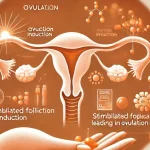A Blog by Midwives Lelystad
Today we discuss a topic that can sometimes cause confusion: ovulation bleeding. You may have heard of it before, or it may be a completely new concept to you. Either way, we’re here to answer all your questions and ease any concerns you may have. In this article, we’ll dive into what ovulation bleeding is, why it happens, and what you can do if you experience it yourself.
What is ovulation bleeding?
Ovulation bleeding is a light bleeding that occurs around the time of your ovulation occurs, usually halfway through your menstrual cycle. This can be confusing because it can easily be confused with other types of bleeding, such as breakthrough bleeding. However, ovulation bleeding is usually very light and last only one to two daysThis is a normal phenomenon that occurs in many women.
Common symptoms of ovulation bleeding:
- Light spotting (pink or brownish discharge)
- No or mild cramps
- Occurs around day 14 of the cycle
Although ovulation bleeding is usually harmless, if you have any doubts you can always contact Midwives Lelystad. We are here for you!
The cause of ovulation bleeding
Ovulation bleeding is caused by a sudden drop in hormones estrogen and progesterone during ovulation. This can cause the lining of the uterus to bleed slightly temporarily. In addition, the lining is extra sensitive and thin during this phase, which can contribute to the bleeding.
To avoid confusion, we have listed the main differences between ovulation bleeding and menstrual bleeding:
| Feature | Ovulation bleeding | Period |
|---|---|---|
| Intensity | Light bleeding | Heavier bleeding |
| Colour | Red or pink | Red or dark red |
| Duration | 1-2 days | 3-7 days |
| Cramps | Usually no cramps | Cramps are common |
Ovulation bleeding vs. implantation bleeding
An ovulation bleed and a implantation bleeding look similar, but there are a few important differences:
| Feature | Ovulation bleeding | Implantation bleeding |
| Time of day | Middle of the cycle | 6-12 days after fertilization |
| Colour | Light red | Light pink or brown |
| Duration | 1-2 days | 1-2 days |
If you notice that the bleeding is heavier than normal or is accompanied by other symptoms such as pain or dizziness, contact Midwives Lelystad.
Ovulation bleeding and recognizing your fertile days
Recognizing ovulation bleeding can be tricky, but it can be an indication that you fertile days have arrived. This can be useful if you want to get pregnant. Look for the following signs:
- Light bleeding around day 14 of your cycle
- Change in cervical mucus – Clear, stretchy and protein-like
- Mild cramps on one side of the lower abdomen
- Increased libido and bloating
When to see a doctor?
Although ovulation bleeding is usually harmless, there are situations where medical attention may be necessary:
- If the bleeding lasts longer than a few days
- If you experience severe pain or other unusual symptoms
- If you regularly have spotting outside your normal cycle
- If there are hormonal problems in your family
When in doubt, it is always wise to seek advice from your midwife or general practitioner.
Conclusion
Ovulation bleeding is a common, normal occurrence that is not a cause for concern. By recognizing the right signals, you can better understand what is happening in your body. Do you still have questions or doubts? Please feel free to contact Midwives Lelystad. We are always here for you!
Stay informed!
Follow us on social media for the latest news and valuable tips on pregnancy and women's health. Discover inspiring real-life stories and stay connected with our expert team.
Take care of yourself and your body!
With kind regards,
Midwives Lelystad
Midwives Lelystad
Address: Badweg 21, 8223 PA Lelystad
Telephone: 06 53 65 91 91








